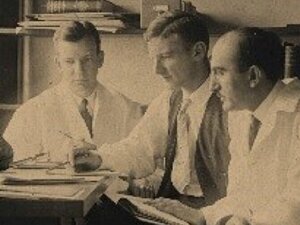Claude Beck, Eliot Cutler, Samuel Levine: The Peter Bent Brigham Hospital team that performed the world’s first successful heart valve surgery.
Visit the event website to register
In 1923, Dr. Elliot C. Cutler conducted the world’s first successful mitral valvuloplasty at Brigham and Women’s Hospital (then Peter Bent Brigham Hospital). On October 20, 2023, the Brigham will mark this important milestone with an all-day CME event looking at past, present, and future approaches to managing mitral valve disease.
“We wanted to recognize the contributions of Dr. Cutler, who was the surgeon-in-chief here for many years and a hero in the development of heart surgery at this institution,” says Mark J. Cunningham, MD, interim chief of Cardiac Surgery at the Brigham. “This is an opportunity to celebrate Dr. Cutler and the history of cardiac surgery here while also talking about new research protocols and contemporary techniques that we’re doing in the mitral space.”
An Era in Which Mitral Stenosis Was Usually Fatal
In the early 1920s, the invention of the heart-lung machine was still three decades away. Given that heart surgery of any kind was considered too risky—and treating mitral stenosis with medicines was generally inefficacious—the disease was often a death sentence.
Dr. Cutler’s case involved a 12-year-old girl dying of rheumatic mitral stenosis. According to a 2015 paper in Annals of Cardiothoracic Surgery by three Brigham physicians, “Cutler pushed a knife through the apex of the left ventricle, then encountered the mitral orifice and performed a blind mitral commissurotomy.”
This was not only the first successful valve surgery of any kind but also the first time someone used an instrument to perform an intervention on the mitral floor. Although the patient was discharged several days later, she went on to die of pneumonia in 1927, according to a paper published in The Annals of Thoracic Surgery.
Dr. Cutler later developed a device to treat mitral stenosis by creating controlled mitral regurgitation. After all seven operations using this device resulted in patient deaths, he discontinued mitral valve repair in 1929.
Addressing the Debate on Approaches to Mitral Valve Treatment
The event celebrating Dr. Cutler’s surgical breakthrough will take place at the Joseph B. Martin Conference Center, just steps from the Brigham’s main campus and Harvard Medical School.
Scheduled highlights include:
- Eugene Braunwald, MD, faculty dean for academic programs at Mass General Brigham and former chief of Cardiology at the Brigham, offering an introduction
- Richard J. Shemin, MD, chief of the Division of Cardiac Surgery at UCLA Health and former faculty member at the Brigham, discussing the history of mitral valve repair at the Brigham
- Tirone David, MD, FRCSC, chair of Cardiovascular Surgery at the Peter Munk Cardiac Centre at the University of Toronto, speaking about the mitral valvuloplasty procedure
- David Adams, MD, chairman of the Department of Cardiovascular Surgery at the Icahn School of Medicine at Mount Sinai, cardiac surgeon-in-chief of the Mount Sinai Health System, and former faculty member at the Brigham, speaking about malignant arrhythmia syndrome
In addition, Dr. Cunningham will review the Brigham’s role in the evolution of mitral valve treatment, while other Brigham faculty will address topics including the debate over catheter-based procedures versus open heart surgery.
“The Brigham is a leader in the treatment of mitral valve disease and in advancing the field via innovative research projects, and this event will highlight both,” Dr. Cunningham says.
Visit the event website to see the agenda and register. Tuition fees are $150 for physicians, $100 for nurses and physician assistants, and $50 for fellows and trainees.
